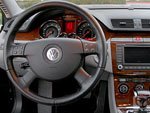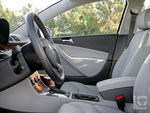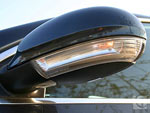 Ever get the idea that Volkswagen likes to take really long vacations before getting to work on its next car? The last time these guys lobbed a Passat over the Atlantic, teenagers were tubthumping along to Chumbawamba, Monica Lewinsky was hitting her head on the underside of a desk, and Leonardo DiCaprio was the king of the world. Maybe Volkswagen figures its cars are so unique, innovative, and gosh-darn special that they don't need to be replaced.
Ever get the idea that Volkswagen likes to take really long vacations before getting to work on its next car? The last time these guys lobbed a Passat over the Atlantic, teenagers were tubthumping along to Chumbawamba, Monica Lewinsky was hitting her head on the underside of a desk, and Leonardo DiCaprio was the king of the world. Maybe Volkswagen figures its cars are so unique, innovative, and gosh-darn special that they don't need to be replaced.There's some truth to that. The Passat has always been one to go its own way, with its manual transmissions, turbochargers, station wagons, all-wheel-drive, 8-cylinder engines arranged in the shape of a W, key-operated windows, and air-conditioned gloveboxes keeping things interesting. For anyone fed up with the cornucopia of sedate sedans from the Far East and Near West, VW was the only game around.
But by 2005, the somewhat small and slow Passat had fallen out of favor. The 2006 is here to address that, with acres of reinvented machinery riding atop a new platform - one that severed its former ties to the Audi family. News exists on nearly every engineering front, and several versions got lost in the model reshuffling. In other words, everything past the Passat's familiar appearance really does suggest eight years worth of work.
Road Test

Volkswagen has shown a recent willingness to tune their cars in line with our tastes, which means the grandest change is with engines. Just when you thought the sedan scene had settled into sanity, Volkswagen goes and punches out its V6 from a perfectly moderate 2.8 liters to a mine's-bigger-than-yours 3.6. How does a 47% increase in power sound? Sounds to me like the Passat's 280 horses just made it the first of its kind to pull off a 0-60 run in 5.9 seconds. Sounds like the Nissan Altima just got drop-kicked into second place. And as for the engine itself, it sounds terrific.
Technology deserves some credit here. Despite the engine's heavy-handed iron construction and a loss of one valve from each cylinder (down from five to four), Volkswagen's latest V6 makes more power than ever thanks to direct fuel injection, which lets the fuel bypass the intake port and squirt straight into the combustion chamber, allowing for a sky-high 12:1 compression ratio. All these changes also bless the Passat's other engine, which enjoys a rebirth as a newly invigorated 200-horsepower turbo 2.0-liter 4. I sampled it on the Audi A4. It kicks.
Starting with the obvious, the power is there. Heck, it's everywhere. There's never any need to analyze whether you can pass that other car in time; you can. You can also go around town picking fights with nearly any Mustang built between 1964 and 1998 - and winning. The Passat is yet more proof that our society crossed the line of reasonable power in a front-wheel-drive car a long time ago: floor it from a stop and the tires will scream and squeal all the way to 40 MPH; try accelerating through a turn and you may not turn at all. But as long as you're already moving and the road is straight, just slam your foot down and revel in the excess acceleration. (Fun fact: Passats elsewhere on Earth start with 102 horsepower.)
Not that VW packed punch into the Passat and left the rest alone. That would be most un-German. They also did their deed with the suspension, which is now fully independent on every model (instead of just on all-wheel-drive cars) thanks to a new four-link setup in the back. They also swapped out the conventional steering rack for an electro-hydraulic type. In other news, the body is claimed to be no less than 57% stiffer in torsion than before, and the all-season tires are more aggressively sized at P245/45R17, though they also have 225 more pounds to carry.
So even if for slightly different reasons, the Passat's ride and handling have the same slightly sporty slant they had before. Freeway ripples can hammer through pretty succinctly, but the suspension is comfortable enough on most roads. And while the all-season tires aren't hard to overwhelm, the Passat takes a fairly willing attitude through curves. The switch to electrohydraulic steering sounded ominous, but it somehow comes off as less numb and more natural here than on the new Jetta. However, despite the slippery 0.28 drag coefficient, all that noise coming from the tires and the buffeting wind didn't seem up to autobahn standards. The last Passat did it better.
The Tiptronic automatic transmission abides by all the same rules as before, such as upshifting automatically at redline and downshifting when floored, eliminating it of much of its manual-ness. But it still shifts properly and on-time, and with a total of six gears this year, lets VW one-up (or two-up) every competitor except Mazda and Ford.
The Passat also felt familiar in a few strangely specific ways, even though the last one I drove was of a wholly different breed (a 1.8T 4Motion). Hit the gas and the Passat accelerates normally, then surges ahead once the tachometer swings past 2,000 - yup, just like a turbo engine. Turbos are fun, but wouldn't someone buying a V6 Passat expect linear V6 behavior? Also, VW still hasn't figured out how to program normal behavior into this car's brakes. The pedal is still squashy at times, especially when you press down more than halfway and the antilock kicks in, sending panicky pulsations through the pedal and making you feel like you're about to crash (though with the standard antilock and ESP stability systems, you probably won't).
So even with all the changes, we've gotten a Passat that manages to drive a lot like the last one. Mostly, that's an accomplishment.
Inside & Out

The "Not-So-Standard Features" of the new Passat show themselves one by one, starting with the intangible: class. The last Passat had a knack for making its driver feel special thanks to its rich, aesthetically appealing mix of wood, chrome, and black leather. Despite cheaper plastic this year, most of what we know and loved is back, including what many consider VW's highlight: the ultra-cool blue and red lighting of the instrument cluster. Better yet, the leather on the steering wheel just felt plain nice, not thick and abrasive like on the last Passat.
The next Not-So-Standard Feature: a push-button ignition. Functionally it works like your old ignition switch - off / acc / on positions; hold it in to start the car - except the remote keyfob itself serves as the key, and you only push and pull rather than twist. Show's over.
Yet another Not-So-Standard Feature: an umbrella holder in the front door. Wow, Jeeves, just like a Rolls-Royce.
Scan the dashboard; things stay pretty normal for a while. You've got your comfortable leather front seats (sorry, no more cloth; it's down to vinyl and leather) with three driver memory settings. Dual-zone automatic climate controls, sourced from the new Jetta and working as slick as ever. A somewhat stiff and small glovebox (the other storage spaces compensate) in which a pull-down 6-disc CD changer descends from the ceiling (displaced by the navigation system). But look, that glovebox has an adjustable air conditioner. So does the center console. Down by the shifter there's an Auto Hold button that holds the car in place if you're on a hill - the first sighting of this in an automatic car - and over on the left edge is an electronic parking brake. So tally up three more Not-So-Standard Features, plus two more on the outside: mirrors that contain blinkers and puddle lights. And I suppose the eight paperback novels that comprise the owner's manual raise that tally to 13.
Let us also remember the Passat for being first to bring the telescoping steering wheel and a full array of six air bags to this class. Those airbags are now standard and now carry the option of two more in the rear doors at body level.
The one feature that sets standards surrounds you from all sides: the stereo. Hailing from a Danish company called DynAudio, its head unit sends a 600-watt monsoon of lifelike hi-fi through ten speakers. As in all VWs, all speakers are contained in the doors, giving all passengers an equal distribution of sound instead of blasting rear-seat passengers from the shelf. But blast it all you like; it's got the juice to handle it and sounds great at any volume. I'd never heard of DynAudio before. Now I don't need to hear anything else.
Operating the stereo can be a bit of a nuisance, with three of the preset buttons lying across an ocean of a nav screen from the other three, and inadequate steering wheel controls that lack the ability to scroll through them. (Really now, what button gets pushed more than the preset changer?) The need to use your nails to press down on the flush, identical buttons is annoying, and while all Passats can supposedly read MP3s, this one couldn't read mine. The optional nav system has a few quirks of its own (i.e. scrolling upwards in response to clockwise turns of the knob) and lacks a mouse for easy scrolling around the map. At least it doesn't mute the music like systems in some other cars, and in a Volkswagen-like touch, it even says "please" after every instruction.
The new cruise controls are unusual but kind of cool. Pull back on the lever to accelerate by 1 MPH; push in on the stalk-mounted button to decelerate by 1; push up on the lever to accelerate by 5; push down to go down by 5. Not exactly conventional, but the precision is welcome, as is the digital MPH readout that appears in the speedometer (on some Passats). VW never stops looking for ways to enhance stuff we take for granted. Gotta admire that.
VW could had strived to spread the wealth around, but the Passat gets by with another just-adequate back seat. It's a decent bench with enough room for all body parts, a full console and cupholders in the armrest, air vents, a power outlet, and sunshades for every window. But one glance at the gi-normously deep trunk reveals what the back seat could have been. Like the Jetta, the Passat has its sedan duties mixed up, and consequently isn't much roomier inside than the one-foot-shorter original Passat from 1990. Come on, VW, Jetta shoppers who really need room buy Golfs; Passat shoppers who need cargo room buy Passat wagons.
But the trunk is, again, cool. You open it either with the remote or by tilting in the big VW logo (neat), and in either case - presto - it opens all on its own. (Wow, Hans, just like an S-class uber-Benz.) Its hinges don't intrude on space and it's got four handy tie-down hooks, a sectioned-off side compartment, and yet another power outlet. Plus when you tumble down the back seat, the tunnel is as huge as humanly possible.
Other Thoughts

Comparing the Passat's lineup to last year's, the diesel's dead, the W8's dead, the wagon's dead (for now), you can't combine 4 cylinders with all-wheel-drive anymore (a bad idea anyway), you can't combine a stick with the V6 (a good idea), and they don't say GL, GLS, and GLX anymore. That leaves us with the 2.0T Value Edition (stick/auto), 2.0T (stick/auto), 3.6 (auto), and 3.6 4Motion (auto).
$23,565 buys the least expensive Passat, a manual transmission Value Edition. Add the $1,075 automatic and that becomes $24,640. For $950 more, the 2.0T adds alloy wheels, pass-through rear armrest, power driver's seat (if you've seen VW's dumb manual seats, you know the importance of this), some ambient interior lighting, and a little chrome on the window frames. The 2.0T also opens the door to optional leather seats, seat heaters, navigation, and the DynAudio stereo.
On the V6 side, the Passat 3.6 begins at $30,565, with the $1,950 all-wheel-drive of the 4Motion model bringing the total to $32,515. V6 cars get an in-window antenna, chrome-accented grille, power sunroof and manual sunshade, 17-inch wheels, and 6-disc CD changer; you can tell the 4Motion apart by the exhaust pipes split between the left and right sides. It takes a V6 to get luxury content like automatic headlights, automatic wipers, automatic climate control, automatic mirror, wood or aluminum trim, side and rear window sunshades, driver seat/mirror memory, HomeLink, and a 3-spoke steering wheel with Tiptronic shifters. Warning: VW saved a few cents this year by downgrading the all-wheel-drive system to a Haldex unit like the one Volvos use. That makes the Passat reactive instead of proactive - the rear wheels join in only after slip has occurred. So if you want the best 4Motion you can get, hunt the local lots for a 2005 Passat. (Shouldn't be too hard; our nearest dealer still had some unsold 2004s.)
Our Passat was optioned out to $36,115, a number that elicits a resounding "uhhh. . ." With automatic, V6 versions of the Mazda 6 and Nissan Altima in the 24 range and the top-of-the-line Ford Fusion SEL down near 22, the base price of that Passat 3.6 is on the wrong side of $30,000. [source : automotive.com]
Post a Comment